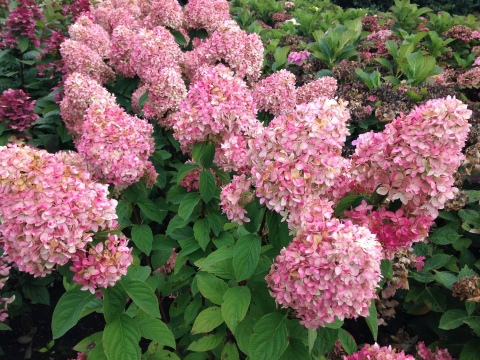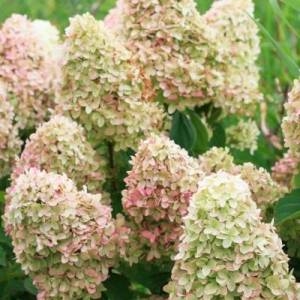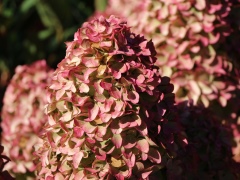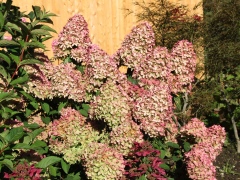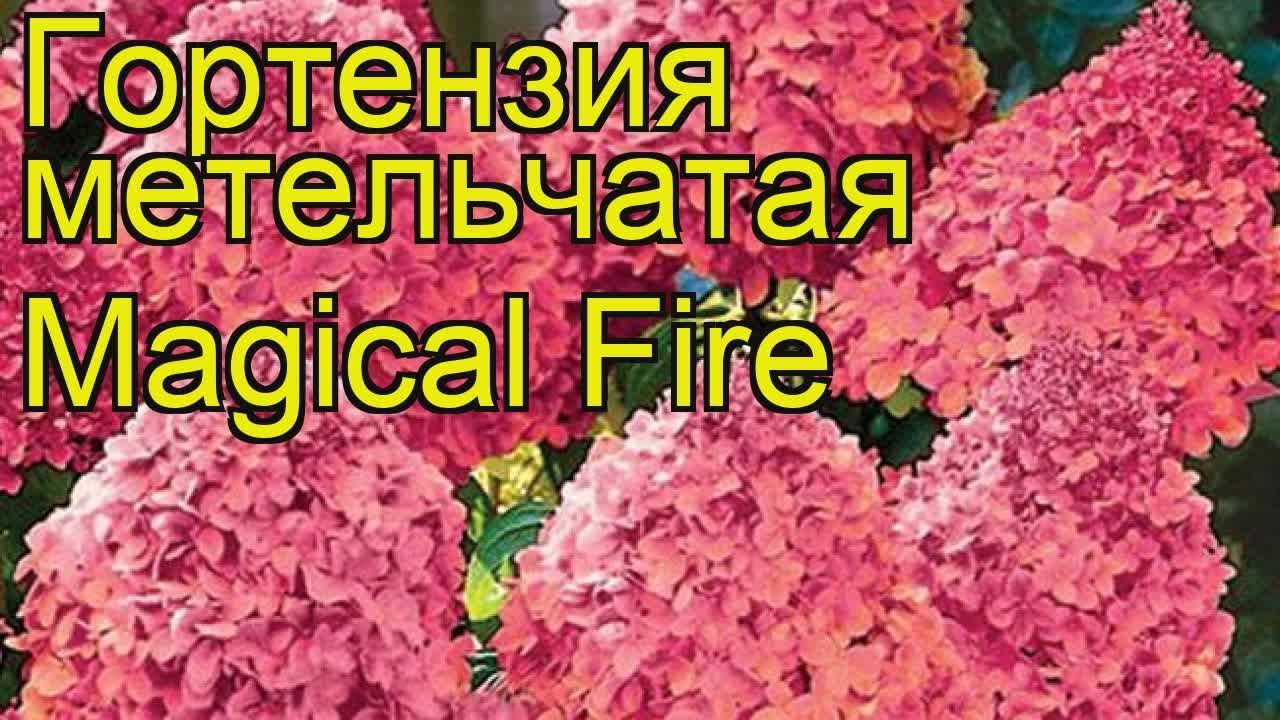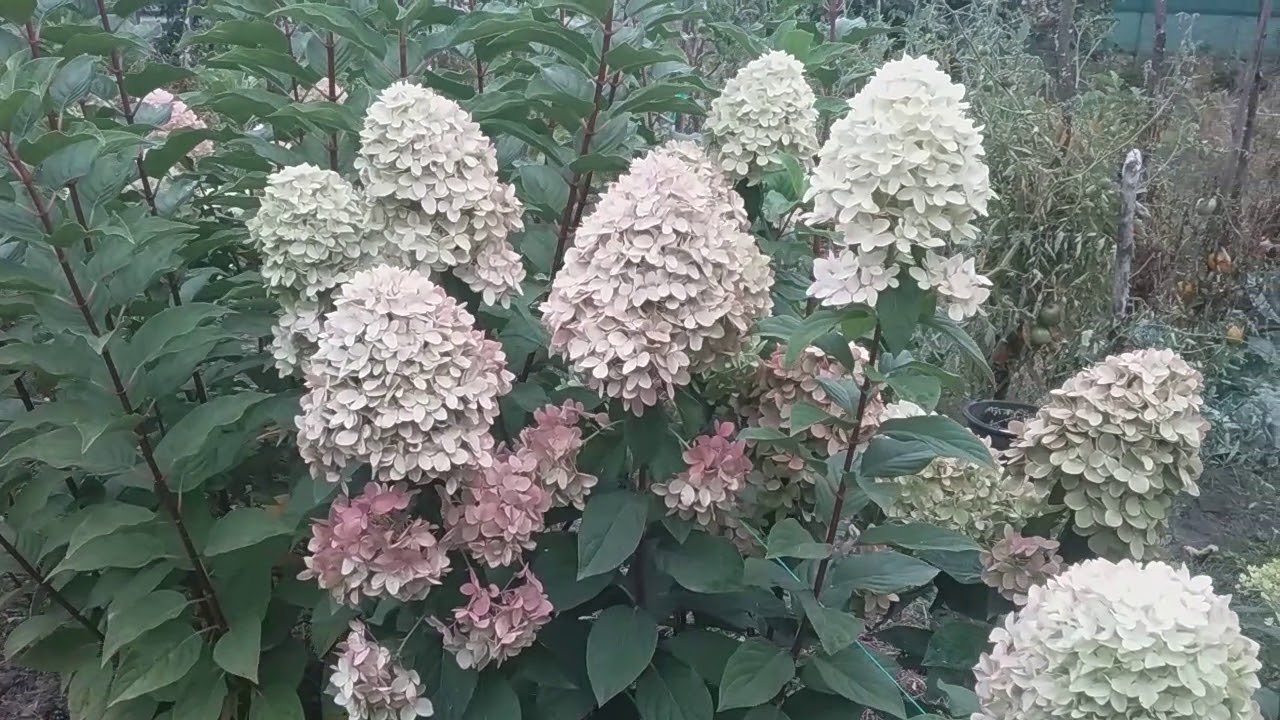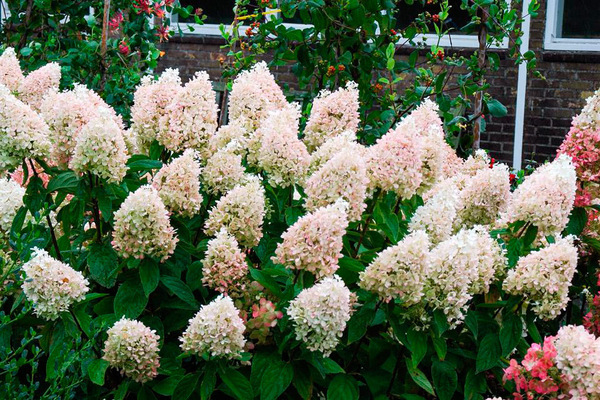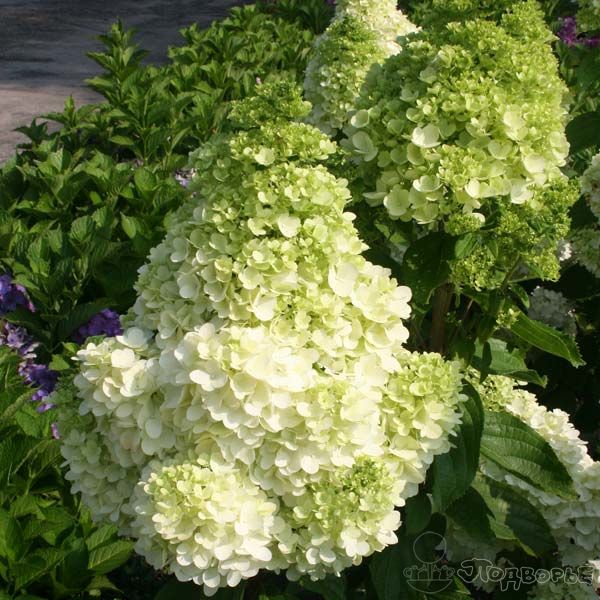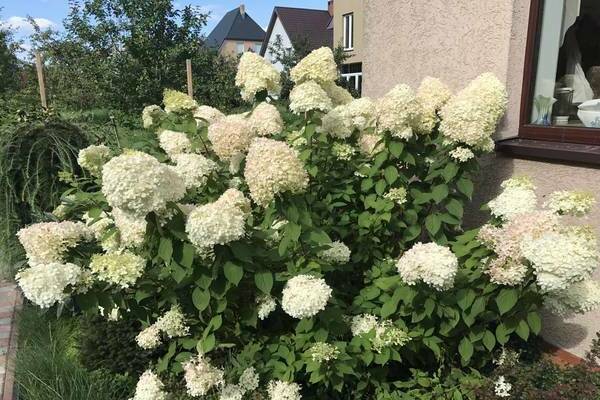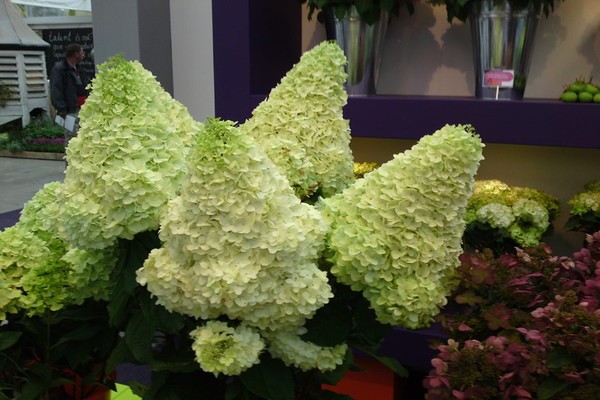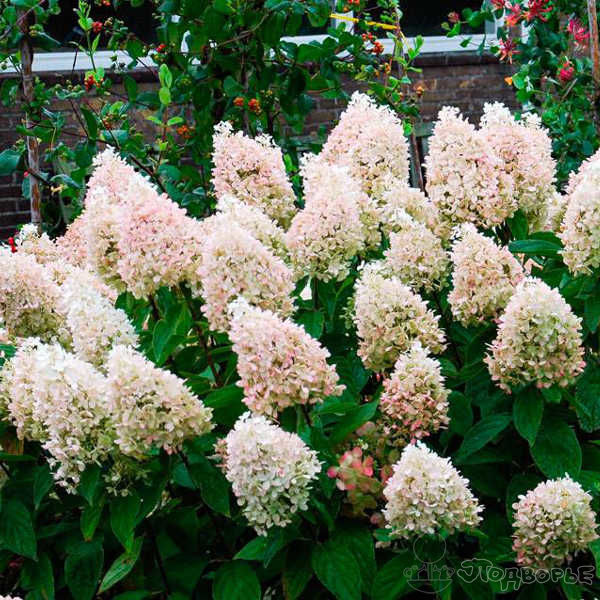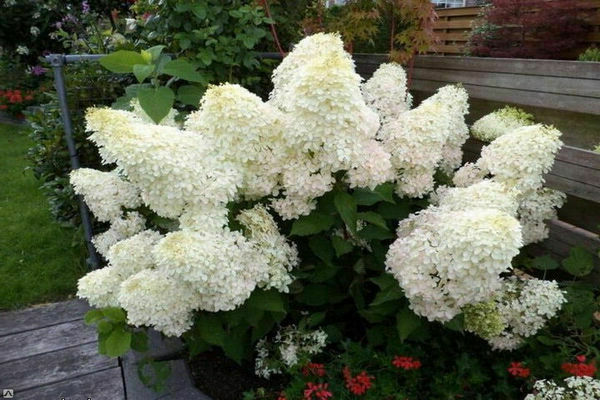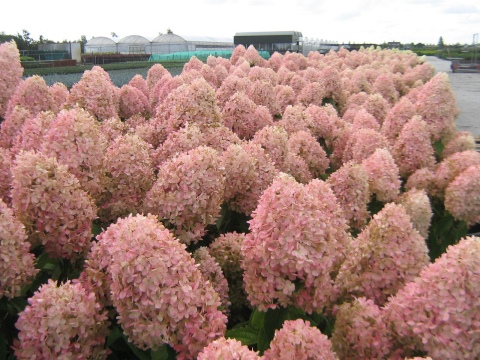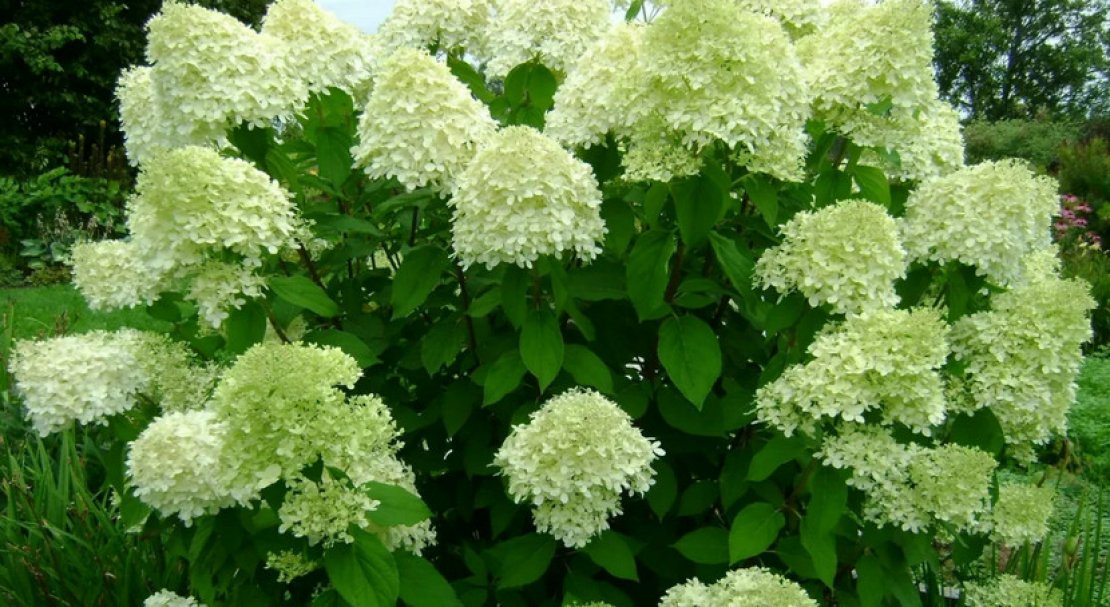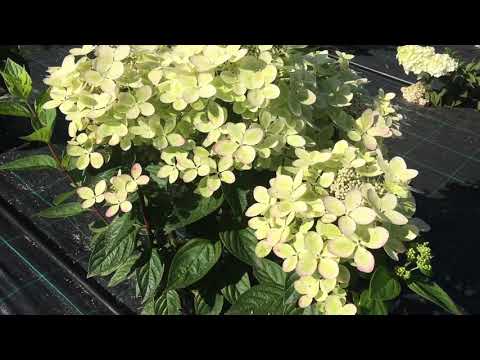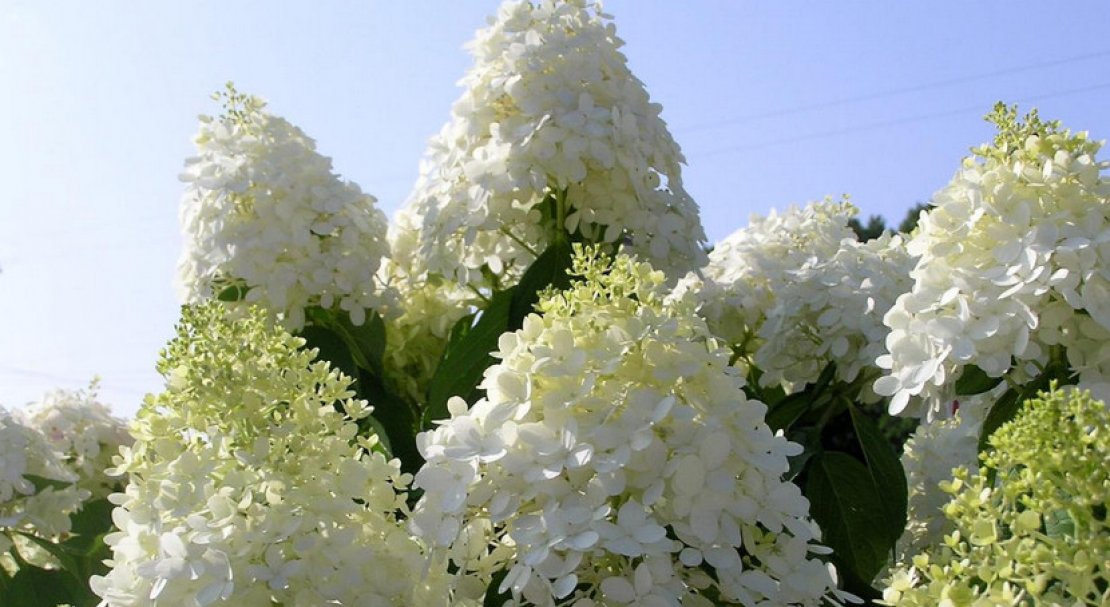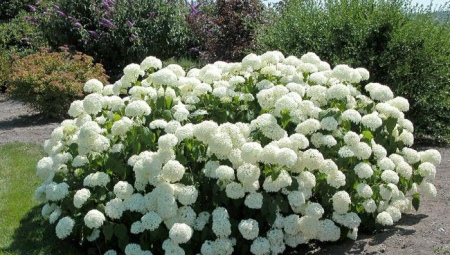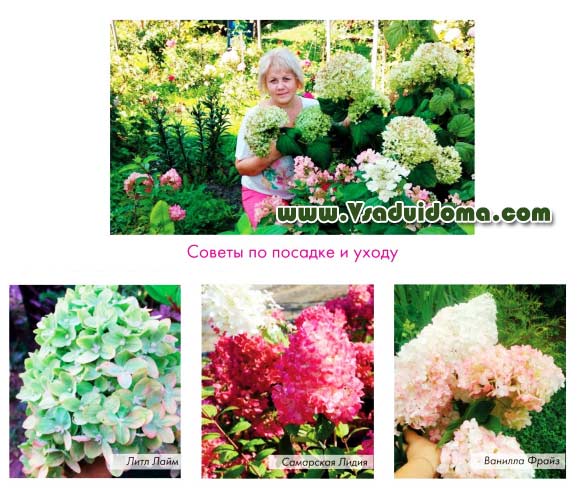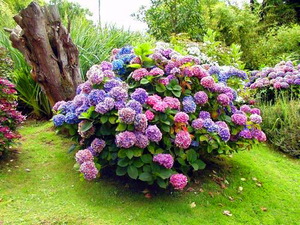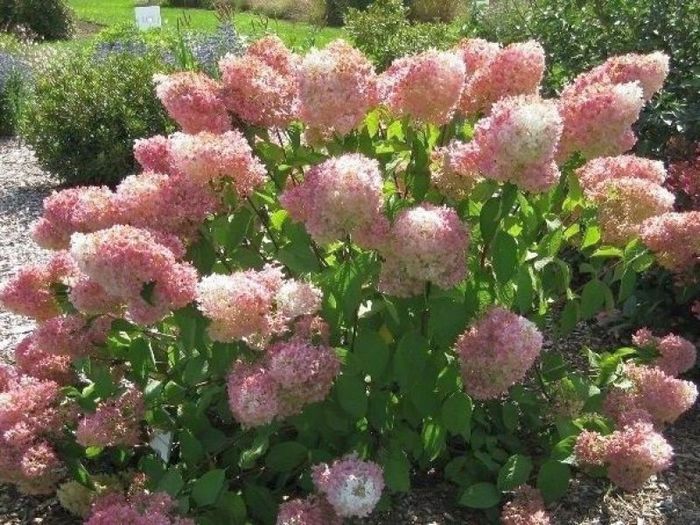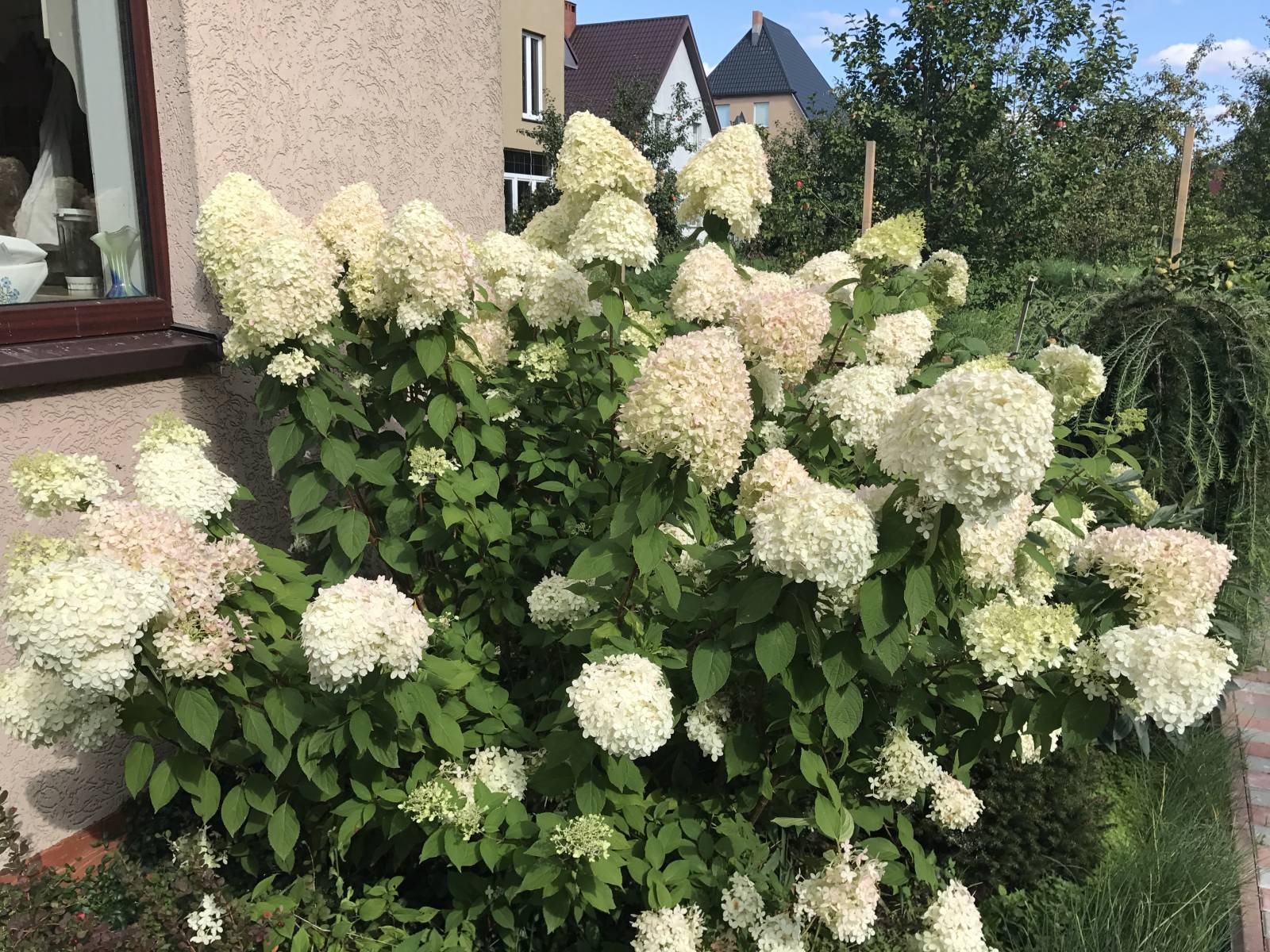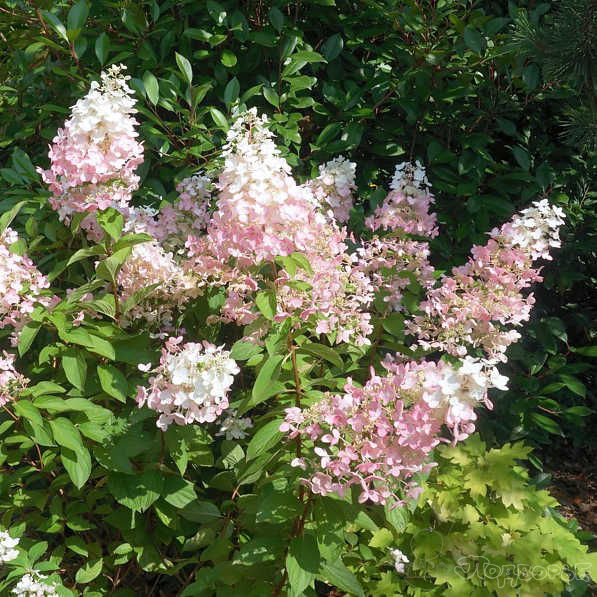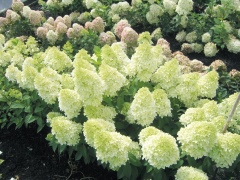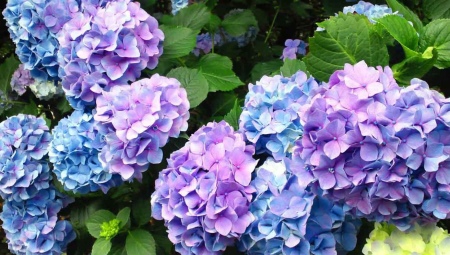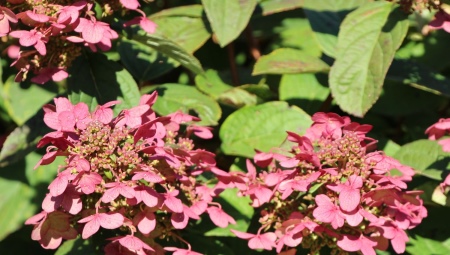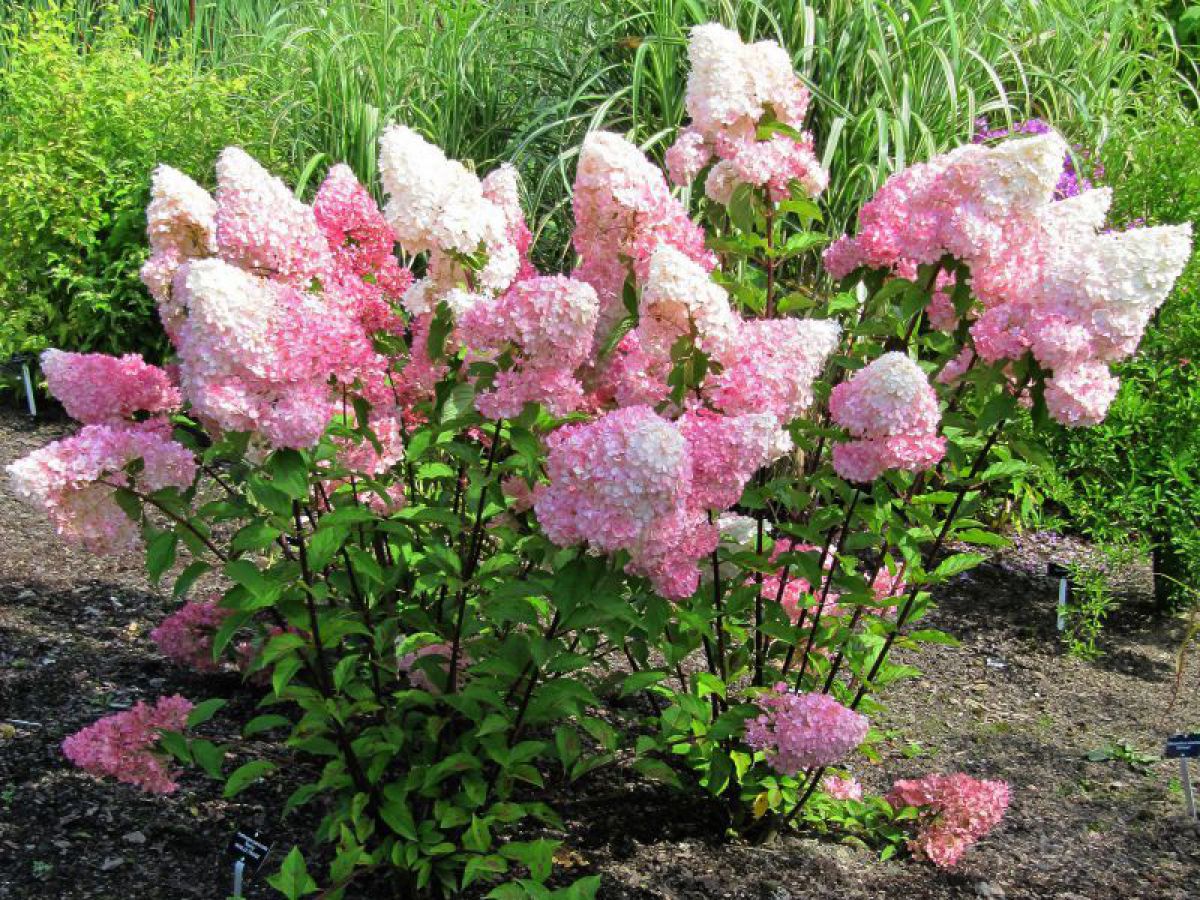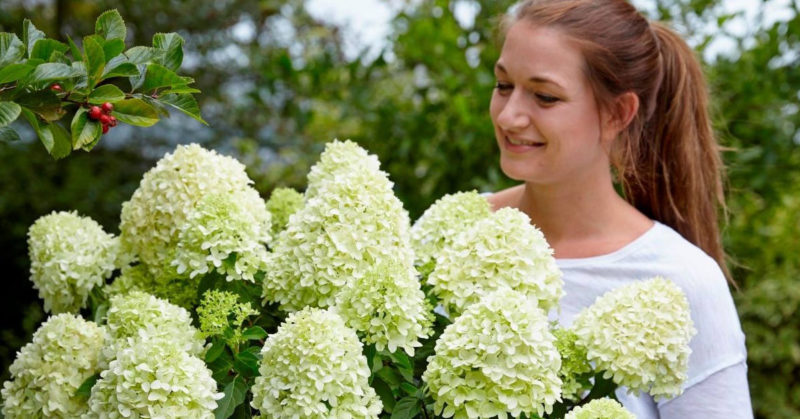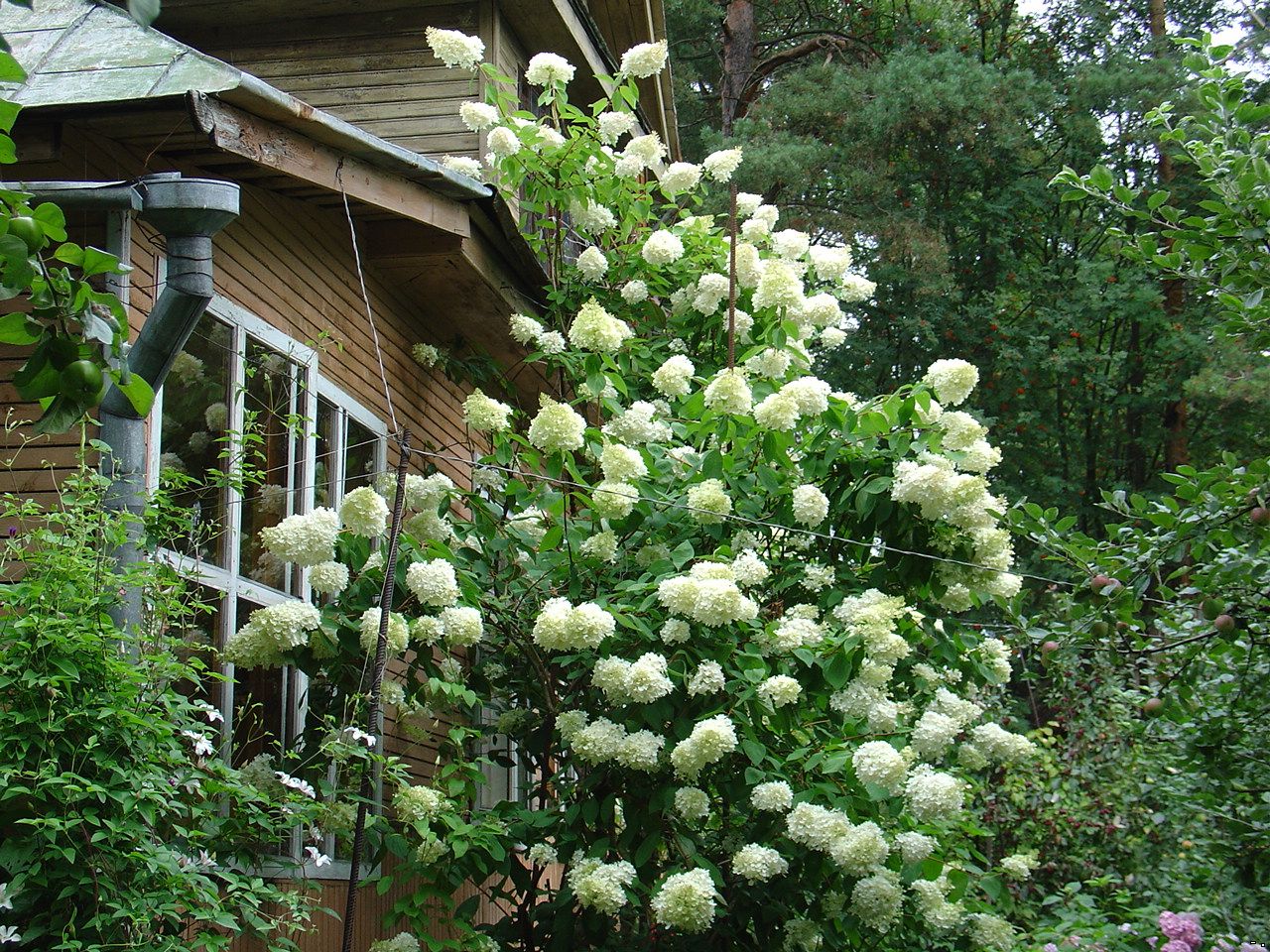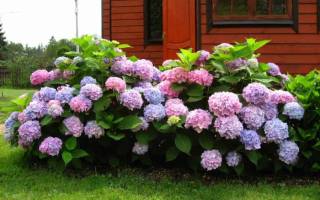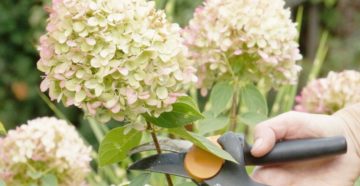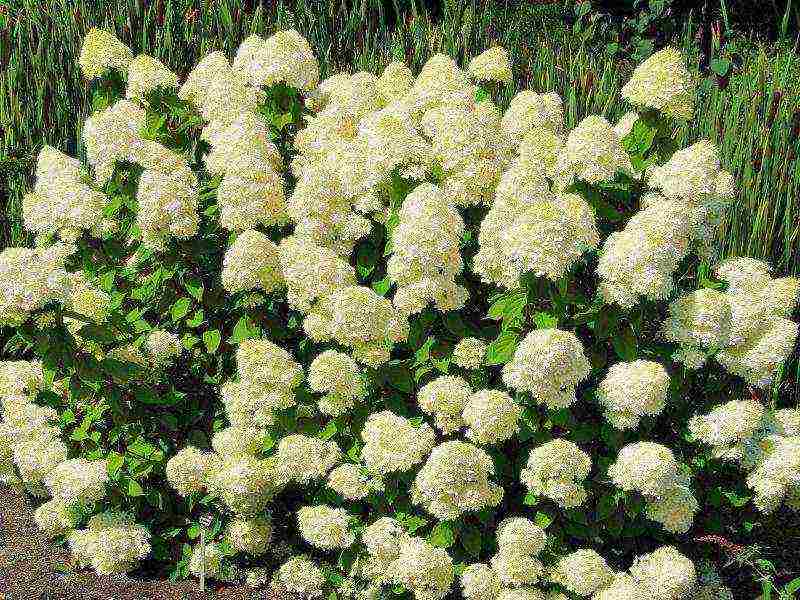Varieties with descriptions, photos and names
Endless summer - so called paniculate. There are many varieties of it, they differ in the color of the flowers, the size of the bush.
Silver dollar
Silver Dollar (Silver dollar) - late flowering variety (flowers bloom in August), blooms until late autumn. The bushes are large, up to 2 meters in height, winter-hardy, the shoots are directed upwards. The shade of the inflorescences is from pale green to snow-white (does not turn pink), large up to 30 cm. Infertile flowers consist of 4 petals. The ideal soil for shrubs is slightly acidic humus. Watering is moderate.
Vanilla Fries
Vanille Fraise is an ideal plant for a large garden. The bush can grow more than 2 meters in height, the inflorescences are large, resembling lilacs. The shade of ombre flowers is from snow white to rich crimson. It blooms from July to September, it can tolerate frosts up to -40 ° C. In case of freezing, the bush is well restored.
Moonlight
Hydrangea paniculata magical moonlight (Moonlight) - shrubs of a round shape, with abundant flowering and large flowers (sterile and fruitful). The flowering period is long - from the beginning of summer to the onset of frost. The shade of the panicles constantly varies from pale green to snow-white and vice versa. The bush grows up to 2 meters in height, tolerates frost rather firmly and recovers well after wintering.
Fraze Melba
Fraise Melba is a variety that selectors have been working on for 10 years and named after the famous strawberry dessert. The cone-shaped inflorescences are large (up to 50 cm), the shade gradually changes from white to bright burgundy, resembling strawberries with cream. The bushes are compact, brown shoots, erect. Flowering lasts from mid-July to late September, sterile flowers.
Diamond Rouge
Diamant Rouge is a compact tree with erect shoots, panicles with large flowers up to 40 cm, the shade of initially white turns into a bright pink almost red color. The foliage of this variety is green in color, and turns orange by autumn. The bushes do not tolerate drought well, they are resistant to frost.
Limelight
Limelight (Limelight) - this variety of paniculata is loved by landscape designers because of the strength of the shoots that do not need support, under the weight of heavy cones with flowers. They bloom at first in lime green (hence the name), and under the sun's rays they become snow-white. At the end of the season, the color changes to pink. Limelight foliage is velvety green, turns purple in autumn. For the winter, shoots should be insulated, especially if the tree is young.
Phantom
Phantom (Phantom) - fragrant abundant flowering plant. Hydrangea begins to bloom from July to September. The color of the panicles is creamy at first, gradually changing color to pink. The phantom requires warming for the winter, by mulching the roots. The bush reaches a size of 2 meters in height and width.
Bobo
Bobo (Bobo) - dwarf hydrangea, blooms profusely and continuously. The panicles vary in color from yellow to pink. This variety is ideal for growing in pots and containers on summer terraces and balconies. It is necessary to shade it and hide it from drafts. The height of the bush is 70 cm, width is 50 cm. The root system requires mulching for the winter.
About the grade
Hydrangea Magical sweet summer was bred by breeders in the Netherlands in 2006. In a short period of time, she became known all over the world, in addition, she is a prize-winner of the Plantarium exhibition. The maximum plant height is 1.5 meters. Its crown is very dense and resembles a ball in shape. The inflorescences can grow up to 13 centimeters in height, they are very similar to inverted bunches of grapes. They are upright and decorate the entire shrub.
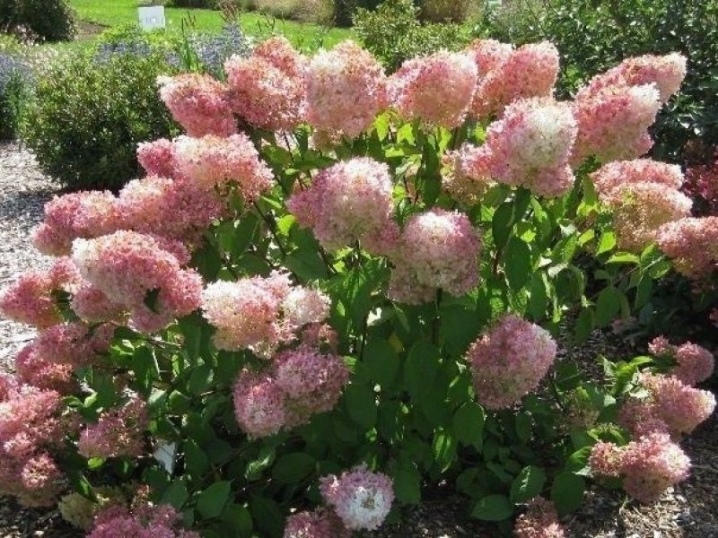
It should be noted that the inflorescences are practically sterile. There are very few fruiting flowers in them. It should be noted that over time they are able to change color. When the buds bloom, they have a light green hue, later turn white and towards autumn they acquire a delicate pinkish color. Flowering begins in July and ends in October.
It should be noted that the leaves are also capable of color changes.At the beginning of the season, they are green in color, and in the fall they turn purple. This allows the plant to look spectacular even when flowering is over. This variety has a fibrous root system. This means that the roots are very close to the surface. Accordingly, they will need a liquid that can be saved by planting in the immediate vicinity of ground cover crops. Plants such as ivy or periwinkle are fine.

Wintering
Hydrangea "Magic Sweet Summer" is frost-resistant. This means that in areas with a temperate climate, adult bushes can winter without shelter. They feel comfortable at temperatures down to -28 degrees. It is best to dig up young plants in the fall, place them in a pot together with the soil and bring them indoors. If you do not stop leaving, hydrangea will delight the gardener with its appearance in winter. However, at the same time, there is a possibility that it will bloom less actively.
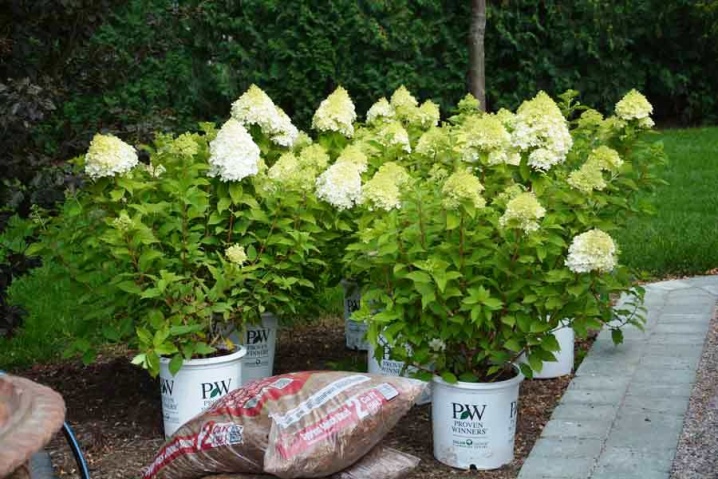
Pruning panicle hydrangea magical
Magic Candle belongs to densely leafy shrubs and needs timely formative pruning. The compact crown of an ornamental flowering garden shrub is prone to thickening, which often creates favorable conditions for flower pests.
Radical pruning is carried out until the buds swell. Damaged, dry, weak branches are subject to complete removal. The remaining shoots are shortened by one third, leaving at least five to six developed buds
It is important to remove all, without exception, branches growing inside the crown of the bush
A well-ventilated aerial part, accessible to sunlight, is the key to the harmonious development of the plant and high resistance against garden pests and infections. Candle brushes that have completed their flowering should be removed throughout the summer. It is noteworthy that dry inflorescences have high decorative qualities. Florists often use them when drawing up bouquets of dried flowers.
Experienced gardeners use the remaining branches after pruning to propagate hydrangeas. Lignified parts of the shoots, containing at least three to four buds, root very quickly in water or sandy-peat substrate. Flowering occurs in the second or third year.
Peculiarities
Hydrangea is very rarely affected by diseases or pests.
Panicle hydrangea, large-leaved and ground cover are predominantly pinkish, creamy colors that can be changed if desired. The color of the hydrangea is directly related to the acidity of the soil. If the soil is slightly alkaline, then the flowering will be pink and crimson; on acidic soils, hydrangea blooms with blue and blue flowers.
Reproduction, planting and growing conditions
Hydrangea is propagated in the following ways:
- cuttings,
- dividing the bush,
- seeds,
- vaccinations.
Its seeds are extremely small, so they are sown in boxes or other containers prepared for these purposes. Summer, still green cuttings treated with heteroauxin root much better than woody similar parts of the plant cut in April.
The optimal time for planting panicle hydrangea is considered to be the off-season: early spring, when the buds have not yet begun to bloom, and autumn - at the end of the flowering stage.
It is advisable to plant this plant on well-drained and moist soil, consisting of a balanced mixture of humus, leafy soil, peat chips and river sand. Hydrangea, for all its unpretentiousness, does not tolerate soil from lime, chalk and wood ash.
If the soil is alkaline on the site, then it must be acidified to a pH level of 4.5-5 with the help of high-moor peat or fertilizers intended for these purposes.
Hydrangea is a light-loving plant that prefers open places without direct sunlight and strong winds, away from trees that can strongly absorb water.
For planting a beautiful shrub, it is recommended to equip a hole, the dimensions of which should be twice the size of an earthen lump of a hydrangea seedling. After that, you need to carefully remove the seedling from the pot, spread its roots, shake the excess soil from them and lower them into the prepared hole, filling them with soil mixed with compost. Having tamped the soil well and covered it with bark or needles, the planted plant is watered abundantly with water.
With a complex planting of panicle hydrangea, it is necessary to dig a trench 90-110 cm wide and observe the distance between the planted shrubs of 140-240 cm.
In order to achieve an earlier flowering of the plant, it is recommended, when carrying out measures for planting it, to dig holes at a closer distance from each other (70-80 cm), which after a few years can be thinned out
It is important to remember that hydrangea has a superficial root system, which is an obstacle to planting it near trees and other shrubs with similar roots, which can become competitors in the struggle of plants for moisture and nutrients.
The panicle hydrangea begins to bloom by the end of the first month of summer and pleases gardeners with its colors and aroma until October.
The flowers of the plant are predominantly pinkish or creamy, which can be changed. It is believed that the color of hydrangea directly depends on the level of acidity of the soil. If the soil is slightly alkaline, then the flowering will be pink and crimson; on acidic soils, hydrangea blooms with blue and blue flowers.
Winter preparation, pruning and shelter
We prepare different types of shrubs in different ways for wintering.
Treelike and panicle hydrangea, does not require reinforced shelter for the winter. It is enough to mulch them well and preserve the root system. They can easily tolerate low temperatures (down to -30 degrees), but they need protection from cold winds. The peculiarity of these varieties is that they have flower ovaries formed on one-year-old sprouts that appear in spring, so their flowering does not depend on wintering. In the fall, we do a strong pruning of shoots.
Large-leaved hydrangeas do not need pruning in the fall. We cut off only weak shoots and all faded inflorescences. If the shoots freeze in winter, then it will no longer bloom. Therefore, she needs good insulation, the same as for roses. The best time for shelter is the end of October. There are no exact dates, it all depends on the weather, the main thing is to be in time before stable frosts.
At the end of summer, we stop watering the bush, thereby giving the green shoots the opportunity to grow stiff faster.
After trying many hiding places, I stopped there. Quickly, accurately, with a minimum of available material. After harvesting the fallen leaves, we do not bend the branches to the ground, but tie them into a bunch.
To protect the roots of plants from freezing, we spud the soil with peat or sawdust at the base of the bush. We cover the tied bundle with a thick layer of dried plants, spruce branches, straw, or brushwood.
From above we wrap the bush in several layers with a covering material: plastic wrap, burlap, roofing felt, a dense spunbond cover (60 g / sq. M.)
It protects well from frost and rodents. Air permeable, does not damp, dries quickly, does not rot. Prevents waterlogging.
In the spring, in this species, we leave the strongest shoots, and cut them so that 5-7 buds remain.
Planting and caring for hydrangea Magic Candle
Magical Candle is an unpretentious garden crop. Getting beautiful and lush-flowering bushes will allow a minimum set of care-related activities.
Selection and preparation of the landing site
The place for planting hydrangea Magic Candle should be sunny. Placing seedlings in partial shade is allowed. The shrub prefers fertile soil, neutral or slightly acidic. Alkaline soils must be oxidized by adding peat or potassium salt. Hydrangea Magic Candle does not like waterlogged soils.
Attention! The acidity level of the soil directly affects the color of the inflorescences. On slightly alkaline soils, they acquire a crimson or pink color, on acidic soils - blue or blue.
Landing rules
The following periods are considered the most optimal time for planting the Magic Candle hydrangea:
- early spring (before bud break);
- autumn (after the end of flowering).
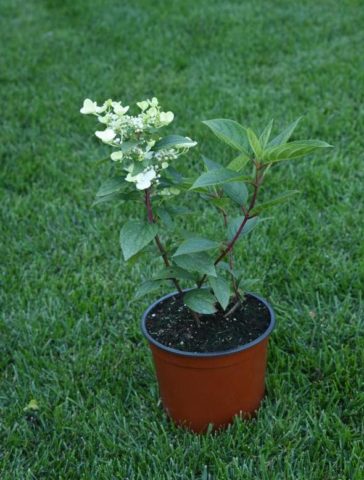
It is not recommended to plant a young flower near similar shrubs and trees, this may cause competition for nutrients and moisture
Step-by-step planting process:
- Prepare the landing pits. Their size should be twice the size of the root system of the seedling. The recommended arrangement of bushes is 1.5x2.0 m.
- Prepare a soil mixture from fertile soil, humus and sand.
- At the bottom of the hole, equip drainage and sprinkle it with prepared soil.
- Place a bush in the hole along with an earthen lump.
- Cover the space around the seedling with soil mixture.
- Tamp the soil tightly around the barrel to prevent air pockets from forming.
- Water the soil abundantly in the trunk circle.
Watering and feeding
Hydrangea Magic Candle is a moisture-loving variety that needs regular and abundant watering. In the hot period, the bushes should be watered often, several times a week, in the moderate period - 4-5 times a month. It is recommended to pour at least 30-50 liters of water under one root. It is recommended to irrigate in the morning and in the evening, when there is no sultry heat.
Advice! You can reduce the frequency of watering by adding peat chips to the soil, which have the ability to retain moisture.
Additional moisture must be provided to plants in dry autumn. Lack of moisture can significantly reduce the winter hardiness of hydrangeas.
Lush flowering is ensured by regular and correct feeding. Fertilizers should be supplied in the dosage required for the plant. An overabundance of nutrients can have the opposite effect. Instead of forming beautiful inflorescences, the hydrangea will produce excess foliage, randomly growing in different directions.
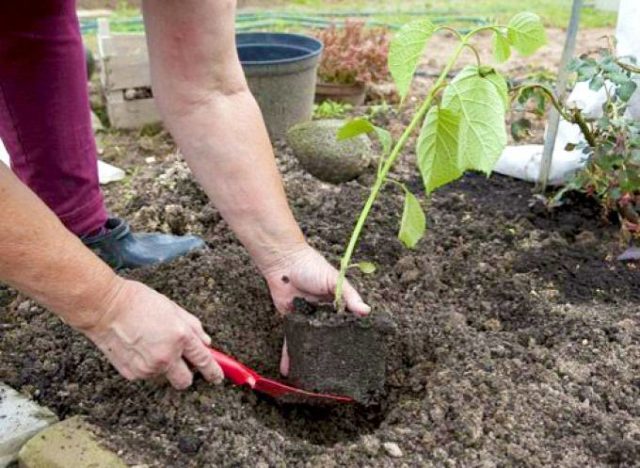
The hole should be 2 times larger in volume than the root of the seedling
To feed the bushes, you can use a variety of fertilizers, which are selected, focusing on the stage of crop growth.
| Nutrients | Rate per 1 m2 of soil |
| At the initial stage of growth | |
| Potassium sulphide | 30-35 g |
| Superphosphate | 35-40 g |
| Urea | 20-25 g |
| During budding | |
| Potassium sulphide | 40-45 g |
| Superphosphate | 60-80 g |
| At the end of the growing season | |
| Compost | 15-20 kg |
Pruning Magic Candle hydrangea
Annual spring pruning allows the bush to form a lush and beautiful crown. It is recommended to carry it out before the start of sap flow. On a young bush, about 10 strong branches are chosen, which are cut off by 1/3, leaving 5 buds. Thin and dry shoots are removed completely.
In a mature plant, all branches are cut off in subsequent years (up to 7 cm in height). This procedure is carried out in order to rejuvenate the shrub.
Also, pruning is the prevention of the appearance of pests, since the thickened crown contributes to their reproduction. At the end of the growing season, cut off all faded inflorescences.
Preparing for winter
The variety is quite frost-resistant, therefore, it is necessary to cover the bushes for the winter only when grown in cold climatic regions, in areas with a significant decrease in winter temperatures, dropping to 25-29 ° C. This rule applies to adult plants. Young seedlings need insulation, regardless of the region of cultivation. For shelter, you can use any mulching materials or branches of conifers.


